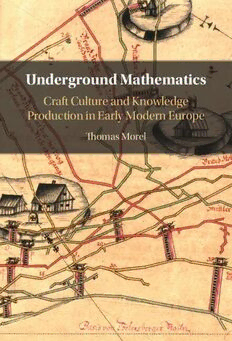
Underground Mathematics: Craft Culture and Knowledge Production in Early Modern Europe PDF
Preview Underground Mathematics: Craft Culture and Knowledge Production in Early Modern Europe
Underground Mathematics Thomas Morel tells the story of subterranean geometry, a forgotten discipline that developed in the silver mines of the Holy Roman Empire. Mining and metallurgy were of great significance to the rulers of early modern Europe, required for the silver bullion that fuelled warfare and numerous other uses. Through seven lively case studies, he illustrates how geometry was used in metal mines by practitioners using esoteric manuscripts. He describes how an original culture of accuracy and measurement paved the way for technical and scientific innovations, and fruitfully brought together the world of artisans, scholars, and courts. Based on a variety of original manuscripts, maps and archive material, Morel recounts how knowledge was crafted and circulated among practitioners in the Holy Roman Empire and beyond. Specific chap- ters deal with the material culture of surveying, map-making, expertise, and the political uses of quantification. By carefully reconstructing the religious, economic, and cultural context of mining cities, Underground Mathematics contextualizes the rise of numbered information, practical mathematics, and quantification in the early modern period. Thomas Morel is Professor of the History of Mathematics at the University of Wuppertal, Germany. Underground Mathematics Craft Culture and Knowledge Production in Early Modern Europe Thomas Morel University of Wuppertal Shaftesbury Road, Cambridge CB2 8EA, United Kingdom One Liberty Plaza, 20th Floor, New York, NY 10006, USA 477 Williamstown Road, Port Melbourne, VIC 3207, Australia 314–321, 3rd Floor, Plot 3, Splendor Forum, Jasola District Centre, New Delhi – 110025, India 103 Penang Road, #05–06/07, Visioncrest Commercial, Singapore 238467 Cambridge University Press is part of Cambridge University Press & Assessment, a department of the University of Cambridge. We share the University’s mission to contribute to society through the pursuit of education, learning and research at the highest international levels of excellence. www.cambridge.org Information on this title: www.cambridge.org/9781009267304 DOI: 10.1017/9781009267274 © Thomas Morel 2023 This publication is in copyright. Subject to statutory exception and to the provisions of relevant collective licensing agreements, no reproduction of any part may take place without the written permission of Cambridge University Press & Assessment. First published 2023 A catalogue record for this publication is available from the British Library. ISBN 978-1-009-26730-4 Hardback Cambridge University Press & Assessment has no responsibility for the persistence or accuracy of URLs for external or third-party internet websites referred to in this publication and does not guarantee that any content on such websites is, or will remain, accurate or appropriate. For my parents Contents List of Figures page viii Acknowledgements x Introduction 1 1 Of Scholars and Miners 20 2 A Mathematical Culture: The Art of Setting Limits 50 3 The Mines and the Court 83 4 Writing It Down: Innovation, Secrecy, and Print 118 5 ‘So Fair a Subterraneous City’: Mapping the Underground 149 6 How to Teach It? Finding the Right Direction 183 7 ‘One of Geometry’s Nicest Applications’: Crafting the Deep-George Tunnel (1771–1799) 213 Conclusion 243 Bibliography 253 Index 281 vii Figures I.1 Frontispiece of Nicolaus Voigtel’s Geometria subterranea (1686) 2 1.1 Measuring the depth of a shaft according to Agricola’s De re metallica (1556) 33 1.2 Mine surveying as presented in the Schwazer Bergbuch (1554) 35 1.3 Working document of subterranean surveyor Hans Dolhopp (ca. 1603) 36 1.4 Measuring the depth of a well according to Oronce Finé’s Protomathesis (1532) 39 1.5 Measuring the depth of a shaft according to Erasmus Reinhold’s Vom Marscheiden (1574) 44 2.1 Preliminary survey of a mine concession 57 2.2 Mining concessions on the outskirts of Altenberg 60 2.3 Setting of concession limits in the gallery, as presented on a surveyor’s manuscript 63 2.4 Title page of Cyriacus Spangenberg, On Dr. Martin Luther (1574) 72 2.5 Frontispiece of Peter Eichholtz’s Spiritual Mine (1655) 80 3.1 Allegorical view of the mining city of Freiberg during the silver rush 87 3.2a Map of the Schwarzenberg mining district 95 3.2b A detail from Figure 3.2a showing the mining compass in the legend to the map of the Schwarzenberg mining district 96 3.3a Principle of the spiderweb surveying method acording to Lehmann’s Historischer Schauplatz (1699) 108 3.3b Use of the spiderweb surveying method in a map by Matthias Öder (1608) 109 3.4a Surveying instrument by Christoph Trechsler (1589) 112 3.4b Drawing of the ‘astronomical device’ used by Melchior Jöstel in 1604 113 4.1 Title pages of two subterranean geometry manuscripts 122 4.2 The right triangle, also known as ‘master of mathematics’ 125 4.3 Mine survey by Jobst Henning Tolle (1699) 127 4.4 Subterranean geometry certificate of Gottfried Klemm 132 viii List of Figures ix 4.5 Register of the ‘written books’ of the late surveyor Sartorius 146 5.1 Portrait of Abraham von Schönberg 150 5.2 Sketch of an abandoned draining gallery 158 5.3 First page of Johann Berger’s Freiberga subterranea (1693) 161 5.4 The mining pits Zscherper and Consolation of Israel 162 5.5 Frontispiece of Berger’s Freiberga subterranea (1693) 166 5.6 Geometrical draft plan of the Holy Father gallery 168 5.7 Frontispiece of Abraham von Schönberg’s Ausführliche Berg-Information (1693) 172 5.8 Portraits of Georg Friedrich von Schönberg and Caspar von Schönberg 181 6.1 ‘Drawing problems’ solved by an applicant for a Freiberg mining grant 188 7.1 The Harz mines in Héron de Villefosse, De la richesse minérale (1819) 214 7.2 Field book of Johann Christian Heinrich Länge (1774) 221 7.3 Prospective plan of the Deep-George draining tunnel drawn by surveyor Länge 222
